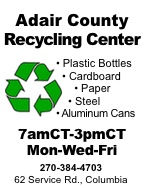| ||||||||||
Dr. Ronald P. Rogers CHIROPRACTOR Support for your body's natural healing capabilities 270-384-5554 Click here for details 


Columbia Gas Dept. GAS LEAK or GAS SMELL Contact Numbers 24 hrs/ 365 days 270-384-2006 or 9-1-1 Call before you dig Visit ColumbiaMagazine's Directory of Churches Addresses, times, phone numbers and more for churches in Adair County Find Great Stuff in ColumbiaMagazine's Classified Ads Antiques, Help Wanted, Autos, Real Estate, Legal Notices, More... 
|
History Monday: Preserve Now, Enjoy Later, is not a new idea By Mike Watson Home canning of garden produce is certainly not a new idea, but with the recent fears of shortages during the era of pandemic, home canning has become a "new" experience for some. Many of us grew up on canned vegetables and fruits. All farm families processed what they produced in order to survive; eating quality home grown foods was an everyday experience. Today, a whole new generation is learning the ways and means of preserving their own winter supplies for the pantry. With the coming of World War II the U.S. Government encouraged home canning and preserving of locally grown produce. The Victory Garden was not just a hobby, not just a whim, but a patriotic service. It was encouraged to help feed one's own family as well as freeing-up the national food supply for military service men and women around the globe, as well as to aid in feeding the millions of starving, displaced civilians in war-ravaged nations unable to produce their own supplies. The Kentucky State College of Agriculture, through the Extension Service, began an accelerated campaign in early 1941 to encourage bigger and better home gardens. There was no cannery in Adair County at that time, but the Extension Service encouraged enlarged gardens to grow more vegetables of all types for immediate use and for storing for the coming winter. The year 1943 brought the first cannery to Adair County. The Columbia Board of Education announced a school community cannery in June of that year. It was to be opened to the public in July in the W.P.A. Building, behind the post office. [W.P.A. stood for the Works Progress Administration, a remnant of the Roosevelt New Deal program group that aided many through the lean times, the Great Depression.] Equipment necessary for canning was available for use to all citizens. This was one of many such operations opened in Kentucky and across the nation. It was estimated that 500 cans could be easily processed in a working day. Anyone in the county could use the facility and each person was responsible for bringing their own food, and preparing and processing it, and providing the jars. Miss Frances Shirley, Home Economics teacher at Columbia High School, would be on hand to show how the processing should be carried out. The charge for using the facility was slight, two cents for each pint and three cents for each quart, these charges would cover the expenses of the operation. The Adair County Cannery officially opened for business on July 19, 1943, with Miss Shirley and Mr. James Woody, Agriculture teacher at Columbia High, to assist those coming to can. In addition to glass canning jars, which each canner had to provide, tin cans could be purchased at the cannery at five cents per pint and six cents per quart. Test canning was carried out on July 14 with Mrs. T.C. Little and Mrs. Joe A. Dudley processed ten quarts of beans. The first official day of operation saw thirty-five pints and forty-eight quarts of food canned. First day canners included Mrs. Paul Young, Miss Arlene Young, Mrs. Ivan Shively, Mrs. W.R. Myers, and Mrs. Odis Whitney. No appointments were needed to reserve time in the cannery during the day, but could be scheduled for Thursday nights when it would remain open later hours. Late July saw something new in Columbia. The government sent three thousand cans to the cannery to be filled for use of the Columbia High School lunchroom during the school year. These were to be filled at the cannery free of service charge. There was no money available to purchase vegetables or fruits, so the school asked for donations of excess produce from the citizens of Columbia and Adair County. The Columbia Parent Teacher Association donated their time and effort to can for the lunchroom. To start off the program Mrs. Bingham Moore and Mrs. Richard Shirley donated two and one-half bushels of beans. With the opening of city schools on September 4, Mrs. C.R. Barger assumed supervision of the cannery, which was to continue operation on Monday, Tuesday, Thursday and Friday from nine in the morning until five in the afternoon. By that time, about seven thousand cans/jars had been canned during the summer months. By this point, grinding and canning of meats and rendering lard had been added to the usual processing of vegetables. The end of September brought a slow-down in canning, so the cannery was open only on Saturdays. Then it closed until the first of December. The cannery was again open for regular Saturday business from eight in the morning until two in the afternoon to process fresh meats. There is more to this story, but that's for another day. Nothing new under the sun. This story was posted on 2020-10-19 09:57:32
Printable: this page is now automatically formatted for printing.
Have comments or corrections for this story? Use our contact form and let us know. More articles from topic Mike Watson - History:
History Monday: Why So Named?? Poke Sallet and the Weed History Monday: Earls' Ridge Remembering Miss Winston Adopt a Grave to reserve and honor our history Famous Natives of Adair Co.: Col. Ebenezer Lafayette Dohoney The woes of lack of matrimony in Adair County, 1904 Six Marriages at Roley, Adair County, at Christmas Time, 1896 History Monday: Trip down Crocus and up Sand Lick from 1915 History: Who will remember? View even more articles in topic Mike Watson - History |



|
||||||||
|
| ||||||||||
|
Quick Links to Popular Features
Looking for a story or picture? Try our Photo Archive or our Stories Archive for all the information that's appeared on ColumbiaMagazine.com. | ||||||||||
|
Contact us: Columbia Magazine and columbiamagazine.com are published by Linda Waggener and Pen Waggener, PO Box 906, Columbia, KY 42728. Please use our contact page, or send questions about technical issues with this site to webmaster@columbiamagazine.com. All logos and trademarks used on this site are property of their respective owners. All comments remain the property and responsibility of their posters, all articles and photos remain the property of their creators, and all the rest is copyright 1995-Present by Columbia Magazine. Privacy policy: use of this site requires no sharing of information. Voluntarily shared information may be published and made available to the public on this site and/or stored electronically. Anonymous submissions will be subject to additional verification. Cookies are not required to use our site. However, if you have cookies enabled in your web browser, some of our advertisers may use cookies for interest-based advertising across multiple domains. For more information about third-party advertising, visit the NAI web privacy site.
| ||||||||||



















































